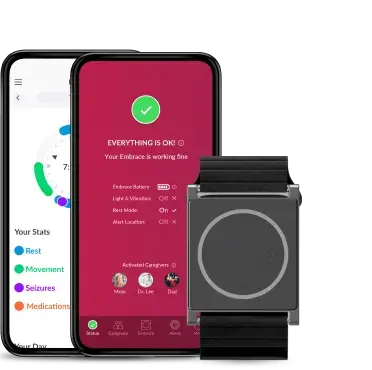PSYCHEDELICS
Using EmbracePlus to measure physiological responses during psychedelic dosing
"So far, almost all of our study participants quickly forgot that they were wearing EmbracePlus - making its utility for psychedelic research a no-brainer.”
Hannes Kettner, PhD student at the University of California San Francisco
This post was co-written with Hannes Kettner, PhD student at the University of California San Francisco (UCSF), and Robin Carhart-Harris, Professor of Neurology at UCSF.
Professor Carhart-Harris became the Ralph Metzner Distinguished Professorship in Neurology and Psychiatry at University of California, San Francisco (UCSF) in 2021 and founded the Carhart-Harris Lab at UCSF in 2023. He moved to Imperial College London in 2008 after obtaining a PhD in Psychopharmacology from the University of Bristol. In 2019 he founded the Centre for Psychedelic Research at Imperial College London and spoke at the World Economic Forum (WEF) in Davos. Carhart-Harris was named among the top 31 medical scientists by The Times newspaper in 2020, listed in TIME magazine’s ‘100 Next’ in 2021, voted psychedelic researcher of the year in 2021, and was listed in Vox Magazine’s ‘Future 50’ in 2023 - a list of positive change makers.
Hannes Kettner (He/Him) is a Ph.D. student at the Imperial College Centre for Psychedelic Research, where he has designed and coordinated several large-scale observational survey studies investigating psychedelic use in naturalistic settings. Under the supervision of Carhart-Harris, he launched the Psychedelic Ceremony Study, which has yielded the largest dataset to date prospectively following participants in guided psychedelic sessions. His work includes over 40 co-authored publications in peer-reviewed journals, many of which have been featured in major media outlets.
Psychedelic therapy (PT) is used for the treatment of neuropsychiatric conditions, including mood and addictive disorders. Its research suggests that psychedelic medicine is best used as a combination approach alongside psychotherapy. In a recent study, Professor Gerhard Grunder MD et al. described PT as, “A form of psychotherapy that uses the profound biological effects of this class of substances as a catalyst for changing thinking, emotions, and behavior” and “One of the most promising current treatment approaches in psychiatry”.
While there is promise that this could be a breakthrough treatment method, there is little research on the role context plays in treatment effectiveness.
This led Carhart-Harris and Kettner to examine the question: How can context impact a dosing experience, and as a result help to improve mental health?
Kettner said, “The guiding principle of PT is that a psychologically supportive context synergizes with a direct psychedelic action to produce safer and more robust therapeutic responses than could be achieved by drug alone, but this hypothesis has so far not been investigated systematically”.
Evaluating the role of set and setting in treatment effectiveness
In their study, using data collected via EmbracePlus and psychometric questionnaires, Carhart-Harris and Kettner are investigating the participants’ physiological responses and overall experience with PT in different contexts. The Set and Setting study aims to assess the role of both 'set' and 'setting' on psychedelic interventions.
The ‘set’ refers to the mindset and expectations someone has about a treatment’s effectiveness and ‘setting’ refers to the environmental context. For this study, both will be assessed together as the ‘context’.
“Given that assumptions regarding context are widely held but insufficiently tested, this study will help validate the hypothesized principles underlying psychedelic therapy and inform on best practices to mitigate risk and maximize therapeutic benefit.”
In their study, two independent variables are being manipulated:
Drug: Administration of the psychedelic psilocybin vs. a placebo
Context: Two different types of setting that vary along a number of hypothesized environmental factors
Kettner said, “The central hypothesis is an interaction between Drug and Context, i.e., a difference in acute and long-term outcomes depending on the context in which psilocybin is administered”.
This study is a 2x2 double-blind randomized controlled trial, monitoring the effects linked to a single dosing session with either psilocybin or placebo. When we asked about the importance of a double-blind randomized trial, Kettner said: “Although functional unblinding is common in psychedelic studies, the double-blind allows us to mitigate the effect of experimenter bias and participant expectations regarding psilocybin – which are furthermore assessed at different points of the trial.”
The study is already underway, but the team plans to recruit 120 volunteers in total who experience low psychological well-being and have little to no prior experience taking psychedelics. Half will receive psilocybin, with the other half getting an inert placebo, and the context condition will be changed for each half of the respective subgroups.
Non-intrusively measuring physiological data with EmbracePlus
The analysis of the primary outcomes will involve testing an interaction effect between the two experimental factors Drug (psilocybin vs placebo) and Context on changes in psychological well-being and acute experiences of emotional breakthrough.
Empatica’s EmbracePlus wearable is being used to measure Electrodermal Activity (EDA), Pulse Rate (PR), Pulse Rate Variability (PRV), Respiratory Rate (RR), and Skin Temperature (ST) in all participants.
When we asked Kettner why wearable technology was chosen, he said: “Wearable technology allows us to measure physiological responses to the different study conditions in a nonintrusive way, which is crucial considering the central role of participant experience and ‘set and setting’ for this study.”
“Without access to wearable devices, cables restraining participants’ movements, as well as the more cumbersome setup of non-wearable biosensors could have negatively impacted participants’ experiences, especially in the state of heightened sensitivity to context we hypothesize to be present under psychedelics.”
But what is the value of using wearable technology specifically in psychedelic research? He said: “In psychedelic research, every assessment that interferes with a subjects’ experience becomes a confounding factor for the study results. So we want to use technology that interferes as little as possible. So far, almost all of our study participants quickly forgot that they were wearing EmbracePlus - making its utility for psychedelic research a no-brainer.”
Moreover, while subjects’ experiences and recollection play a key role in psychedelic science, ensuring objective results are gathered is critical. Kettner supports this, stating: “Through the combination of subjective assessments with longitudinal fMRI, acute EEG and peripheral physiological assessments, we hope to gain more insight into the bodily and neural correlates of psychedelics’ psychological effects.”
What is the value of using Empatica’s technology?
Empatica’s technology was chosen for its long-standing research legacy and reliability. Kettner said: “Our lab has a history of using Empatica’s devices going back to field research conducted at psychedelic retreats using Empatica E4 wristbands, the precursor to EmbracePlus.”
“Ease-of-use and reliability, as well as the intuitive Empatica Health Monitoring Platform stand out as key factors why we chose to continue using Empatica’s technology for our research.”
Designed for both the scientist and the participant
Since data collection has already begun, we asked Kettner how the research team and participants have found Empatica’s technology so far.
“From a researcher’s perspective, working with the EmbracePlus wearables and the associated Empatica Health Monitoring Platform, all the while receiving continuous and immediate support by Empatica staff could not have been a better or more seamless experience.”
“From a research participant’s point of view, EmbracePlus has been so nonintrusive that most of our participants would have taken them home if we hadn’t reminded them that they were still wearing them- the best kind of feedback we could have wished for.”
Are you interested in joining the study?
The research team is actively recruiting more participants and expect to continue their dosing sessions for the next 2-3 years in order to reach their goal of 120 study participants.
If you’re based in the San Francisco Bay Area and would like to find out if you’re eligible, please complete the pre-screening survey following this link: https://ucsf.co1.qualtrics.com/jfe/form/SV_3Kx0ICR0KzTOULA
We look forward to sharing their results in the near future. In the meantime, if you’d like to find out about our platform and 300+ digital measures available, visit our website.
Get the latest from Empatica delivered directly
Shipping destination
Select your region so we can ship your device to the correct location.

United States
$ USD


